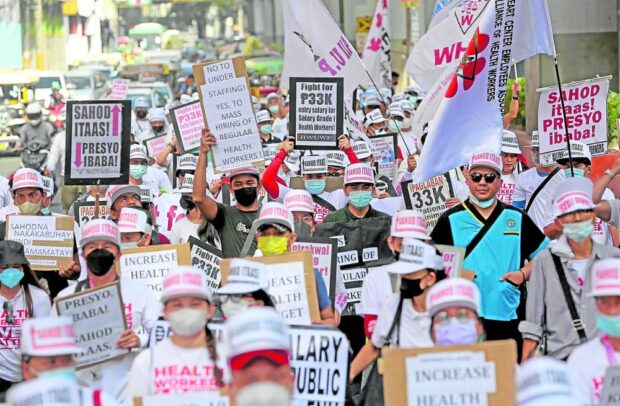DOH told: No nurse shortage, just gov’t ‘understaffing’

DAY OF DISCONTENT Activists demanding higher pay and more benefits for personnel in public and private hospitals and health institutions mark National Health Workers’ Day with a protest march in Manila on Friday. —RICHARD A. REYES
A group of nurses on Friday called out the Department of Health (DOH) for its statement about the country needing 12 years to fill the gap of 127,000 nurses needed in the health-care sector.
Why not hire back the nurses whose contracts have expired and address the issues of understaffing and substandard pay, asked Jocelyn Andamo, secretary general of the Filipino Nurses United (FNU), during a protest march on May 5 to mark National Health Workers’ Day.
The group was responding to DOH officer in charge Maria Rosario Vergeire, who told a House hearing on appropriations on Thursday about the shortage of nurses needed to provide optimal patient care.
“There are so many ‘plantilla’ positions at DOH… why don’t you hire unemployed nurses?,” Andamo asked. “The solution is so simple and it shouldn’t take [12] years [to] address understaffing and increase [nurses’] salary,” she added.
Andamo, a retired community nurse, pointed out that there is no nursing “shortage,” only “understaffing” in hospitals as the country has “enough supply” of nurses. The problem, she said, lies in the lack of government measures for the retention and recruitment of licensed nurses.
Article continues after this advertisement1:12 ‘safe’ ratio
“What’s happening under the nurse deployment program is that they hire job-order nurses [whom] they eventually terminate… instead of absorbing them [as regular employees],” Andamo told the Inquirer on the sidelines of the protest march.
Article continues after this advertisementThe community health advocate stressed the need to implement mass hiring among nurses to meet the “safe” nurse to patient ratio of 1:12 under DOH guidelines, and 1:4 under global standards. The ideal ratio is much lower in special units, such as intensive care units and emergency rooms, where a nurse is expected to manage only one or two patients.
Such safe ratio is “so far from reality,” Andamo said, noting that a typical nurse handles from 20 to 100 patients, depending on the hospital’s resources. “There are nurses who even have to handle a whole ward where, for instance, the nurse, regardless of the patients’ conditions, has to take care of 30 to 50 patients per [work] shift,” she said.
This understaffing could make health-care workers prone to errors, and would ultimately compromise the quality of care needed to achieve favorable health outcomes in patients, Andamo said. “Patients and communities would suffer the most if there is a lack of health-care personnel and nurses in hospitals and [barangay] health facilities,” she pointed out.
Longtime demands
Citing figures from the health department, Andamo said there are more than 600,000 registered Filipino nurses, about half of whom had chosen to migrate to other countries. Nearly a third have meanwhile shifted to other careers, or are either unemployed or underemployed, she added.
Aside from FNU, health-care workers representing various hospital unions and labor groups marched from España to Recto in Manila to press their demands for a wage hike, job security, better working conditions and bigger funding for health care.
A “living wage,” according to the marchers, means an entry-level pay of P50,000 a month for public and private nurses, and P33,000 monthly for the rest of medical personnel under Salary Grade 1. Those working in the private sector should also get a salary increase of P1,100 a day, the groups added.
They also called for the immediate release of delayed pandemic benefits dating as far back to October 2021. The DOH had said that a total of P22.57 billion for both public and private health-care workers have been disbursed to the regional Centers for Health Development.